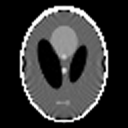Avinash C. Kak
School of Electrical Engineering
Purdue University
Malcolm Slaney
Originally: Schlumberger Palo Alto Research
Currently:
Yahoo! Research

Avinash C. Kak
School of Electrical Engineering
Purdue University
Malcolm Slaney
Originally: Schlumberger Palo Alto Research
Currently:
Yahoo! Research

Originally published by IEEE Press. (C) 1988 Institute for Electrical
and Electronic Engineers.
Electronic copy (C) 1999 A. C. Kak and Malcolm Slaney. You are free
to use this electronic version of Principles of Computerized Tomographic
Imaging for your personal use. No commercial use is allowed without
permission. Please reference this work as
A. C. Kak and Malcolm Slaney, Principles of Computerized Tomographic Imaging, IEEE Press, 1988.or if you prefer
A. C. Kak and Malcolm Slaney, Principles of Computerized Tomographic Imaging, Society of Industrial and Applied Mathematics, 2001
Preface
- PDF File (456K Bytes)
1 Introduction - PDF File (304K Bytes)
References2 Signal Processing Fundamentals - PDF File (4.6M Bytes)
2.1 One-Dimensional Signal Processing
Continuous and Discrete One-Dimensional Functions ° Linear Operations ° Fourier Representation ° Discrete Fourier Transform (DFT) ° Finite Fourier Transform ° Just How Much Data Is Needed? ° Interpretation of the FFT Output ° How to Increase the Display Resolution in the Frequency Domain ° How to Deal with Data Defined for Negative Time ° How to Increase Frequency Domain Display ° Resolution of Signals Defined for Negative Time ° Data Truncation Effects
2.2 Image Processing
Point Sources and Delta Functions ° Linear Shift Invariant Operations ° Fourier Analysis ° Properties of Fourier Transforms ° The Two-Dimensional Finite Fourier Transform ° Numerical Implementation of the Two-Dimensional FFT
2.3 References
3
Algorithms for Reconstruction with Nondiffracting Sources - PDF File
(5.5M Bytes)
3.1 Line Integrals and Projections4 Measurement of Projection Data - The Nondiffracting Case - PDF File (10.2M Bytes)3.2 The Fourier Slice Theorem
3.3 Reconstruction Algorithms for Parallel Projections
The Idea ° Theory ° Computer Implementation of the Algorithm3.4 Reconstruction from Fan Projections
Equiangular Rays ° Equally Spaced Collinear Detectors ° A Re-sorting Algorithm3.5 Fan Beam Reconstruction from a Limited Number of Views
3.6 Three-Dimensional Reconstructions
Three-Dimensional Projections ° Three-Dimensional Filtered Backprojection3.7 Bibliographic Notes
3.8 References
4.1 X-Ray Tomography5 Aliasing Artifacts and Noise in CT Images - PDF File (2.3M Bytes)
Monochromatic X-Ray Projections ° Measurement of Projection Data with Polychromatic Sources ° Polychromaticity Artifacts in X-Ray CT ° Scatter ° Different Methods for Scanning ° Applications4.2 Emission Computed Tomography
Single Photon Emission Tomography ° Attenuation Compensation for Single Photon Emission CT ° Positron Emission Tomography ° Attenuation Compensation for Positron Tomography4.3 Ultrasonic Computed Tomography
Fundamental Considerations ° Ultrasonic Refractive Index Tomography ° Ultrasonic Attenuation Tomography ° Applications4.4 Magnetic Resonance Imaging
4.5 Bibliographic Notes
4.6 References
(Individual sections of this large chapter are also available: 4.1, 4.2, 4.3, 4.4, 4.5& 4.6)
5.1 Aliasing Artifacts6 Tomographic Imaging with Diffracting Sources - PDF File (6.9M Bytes)
What Does Aliasing Look Like? ° Sampling in a Real System5.2 Noise in Reconstructed Images
The Continuous Case ° The Discrete Case5.3 Bibliographic Notes
5.4 References
6.1 Diffracted Projections7 Algebraic Reconstruction Algorithms - PDF File (2.3M Bytes)
Homogeneous Wave Equation ° Inhomogeneous Wave Equation6.2 Approximations to the Wave Equation
The First Born Approximation ° The First Rytov Approximation6.3 The Fourier Diffraction Theorem
Decomposing the Green's Function ° Fourier Transform Approach ° Short Wavelength Limit of the Fourier Diffraction Theorem ° The Data Collection Process6.4 Interpolation and a Filtered Backpropagation Algorithm for Diffracting Sources
Frequency Domain Interpolation ° Backpropagation Algorithms6.5 Limitations
Mathematical Limitations ° Evaluation of the Born Approximation ° Evaluation of the Rytov Approximation ° Comparison of the Born and Rytov Approximations6.6 Evaluation of Reconstruction Algorithms
6.7 Experimental Limitations
Evanescent Waves ° Sampling the Received Wave ° The Effects of a Finite Receiver Length ° Evaluation of the Experimental Effects ° Optimization ° Limited Views6.8 Bibliographic Notes
6.9 References
7.1 Image and Projection Representation8 Reflection Tomography - PDF File (3.4M Bytes)7.2 ART (Algebraic Reconstruction Techniques)
7.3 SIRT (Simultaneous Iterative Reconstructive Technique)
7.4 SART (Simultaneous Algebraic Reconstruction Technique)
Modeling the Forward Projection Process ° Implementation of the Reconstruction Algorithm7.5 Bibliographic Notes
7.6 References
8.1 IntroductionIndex - HTML File (with links) - PDF File (494K Bytes)8.2 B-Scan Imaging
8.3 Reflection Tomography
Plane Wave Reflection Transducers ° Reflection Tomography vs. Diffraction Tomography ° Reflection Tomography Limits8.4 Reflection Tomography with Point Transmitter/Receivers
Reconstruction Algorithms ° Experimental Results8.5 Bibliographic Notes
8.6 References
About the Authors